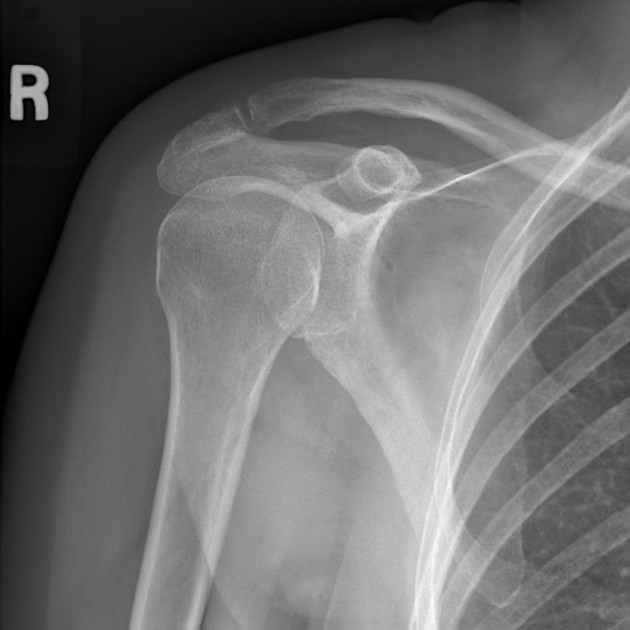Photo Credit: radiopaedia.org
Are you grappling with the discomfort of a bone spur on your shoulder, wondering about its potential impact on your rotator cuff? Worried you’ll regret not getting surgery? At Mend Colorado, we understand the concerns associated with shoulder health, and we’re here to guide you through evidence-based solutions. Read on to learn what research says about addressing bone spurs with nonsurgical alternatives.
The Shoulder Dilemma
When it comes to treating a bone spur on the shoulder, surgery is often considered in an effort to prevent exacerbation, with a particular focus on preserving vital structures like the rotator cuff. However, recent research challenges the conventional wisdom surrounding early surgical interventions. Interestingly, delaying surgery without the risk of rotator cuff progression opens the door to the benefits of physical therapy.
In one retrospective study, Yoon et al. evaluated 119 patients with an intact rotator cuff, an impingement diagnosis, and a 3mm subacromial bone spur (Arch Ortho Trauma Surg. 2018). These patients underwent conservative care, including physical therapy, with follow-up imaging conducted between 2 to 5 years after the initial X-ray. Surprisingly, the study found no progression of rotator cuff tears during this period, suggesting that a spur might not be as crucial to cuff tears as previously assumed.
How to Manage a Bone Spur on the Shoulder Without Surgery
With tailored physical therapy in Boulder and Lafayette, you can address the unique challenges posed by having a bone spur in the shoulder, fostering relief and enhancing overall wellness. Here are some of the most effective approaches your Lafayette or Boulder physical therapy team may take:
1. Therapeutic Exercises
Physical therapy programs encompass a range of exercises that target the specific areas affected by shoulder bone spurs. These exercises improve shoulder joint mobility, strengthen surrounding muscles, and promote optimal biomechanics. By addressing muscle imbalances and enhancing overall shoulder stability, these exercises mitigate the impact of bone spurs on joint function.
2. Manual Therapy Techniques
Skilled hands-on interventions, called manual therapy techniques, can alleviate pain, reduce inflammation, and enhance joint mobility. Soft tissue mobilization, joint mobilization, and massage therapy are among the modalities used to address the intricate interplay between bone spurs and the surrounding structures.
3. Postural Corrections
Effective shoulder health often involves addressing underlying postural issues that may contribute to the development or exacerbation of bone spurs. Consequently, a comprehensive physical therapy program typically includes targeted postural corrections to alleviate undue stress on the shoulder joint, promoting a more sustainable and functional alignment.
4. Education and Lifestyle Modifications
Empowering patients with knowledge about their condition is integral to an effective treatment approach. Skilled therapists aim to treat patients with lifestyle modifications, including ergonomic adjustments and activity modifications, to prevent further aggravation of the bone spur on the shoulder. This proactive guidance enables individuals to make informed choices that support long-term shoulder health.
5. Modalities for Pain Management
Depending on the severity of the condition, modalities such as heat and ice can manage pain associated with shoulder bone spurs. These modalities offer immediate relief while creating an optimal environment for the effectiveness of other therapeutic interventions.
6. Gradual Progression and Monitoring
Since each individual responds uniquely to treatment, the most effective physical therapy programs are characterized by a gradual progression tailored to the patient’s needs. Making periodic adjustments along the way ensures the treatment plan evolves in tandem with the individual’s progress, maximizing the effectiveness of the interventions.
Let Mend Manage Your Shoulder Bone Spur
If you have shoulder bone spurs and need physical therapy in Lafayette or Boulder, the Mend team will take a patient-centric and evidence-based approach. By combining therapeutic exercises, manual therapy, postural corrections, education, and targeted pain management, we will aim to alleviate immediate discomfort while empowering you with the tools needed for sustained shoulder health. Our clinics stand as beacons of expertise, committed to guiding you toward a pain-free and functional future. Click here to embark on your journey to optimal shoulder health.
Click Here For Our Best Exercises
Shoulder Pain, Impingement, Rotator Cuff Injuries


